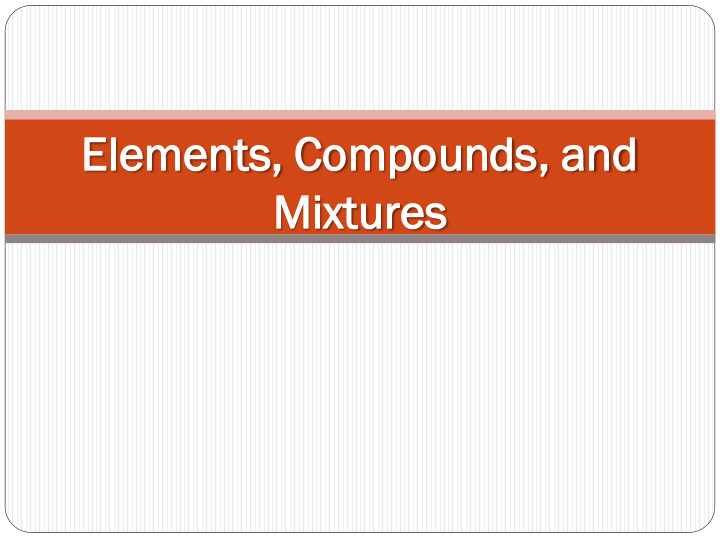



Eleme ment nts, s, Compoun unds, ds, and nd Mixtu xtures res
MATTER Makes up everything Anything that has Mass Takes up space (volume) Is made up of atoms.
Pur ure Sub ubst stan ances ces A sample of matter that has definite chemical and physical properties.
The Atom An atom consists of a Nucleus ( protons and neutrons ) electrons in space around the nucleus. Electron cloud Nucleus
• The building blocks of Matter • Consists of Protons (+), Electrons (-), and Neutrons (N). • Smallest unit of an element that has all of he same properties of that element. Images are from http://www.chem4kids.com
El Elemen ents pure substance that cannot be separated into simpler substance by physical or chemical means.
Com ompou pounds nds Made of elements in a specific ratio that is always the same Have their own physical and chemical properties. Can only be separated by chemical means, not physically Smallest particle is a molecule
• Atoms of two or more different elements joined together by chemical bonds. In the animation above, water (H 2 0 ) is a compound made of Hydrogen and Oxygen. Animated images and notes from http://www.chem.purdue.edu/gchelp/atoms/elements.html
CHEMICAL COMPOUNDS are composed of atoms and so can be decomposed to those atoms. The red compound is composed of • nickel (Ni) (silver) • carbon (C) (black) • hydrogen (H) (white) • oxygen (O) (red) • nitrogen (N) (blue)
• A molecule consists of two or more atoms of the same element, or different elements, that are chemically bound together. • In the animation above, two nitrogen atoms (N + N = N2) make one Nitrogen molecule .
Chemical Bonds Molecules are held together by bonds Ionic bonds Covalent bonds
IONS IONS are atoms or groups of atoms with a positive or negative charge. . To tell the difference between an atom and an ion, look to see if there is a charge in the superscript! Examples: Na + Ca +2 I - O -2 Na Ca I O
Forming Positive & Negative Ions A Positive ion An Negative ion forms when an forms when an atom loses one or atom gains one or more electrons. more electrons F + e- --> F - Mg --> Mg 2+ (2 e- lost)
IONIC BONDS metals (Mg) lose electrons -- positive ion nonmetals (F) gain electrons ---> negative ion OPPOSITES ATTRACT EACH OTHER! positive ion IS ATTRACTED TO negative ion
Cl
Covalent Bonds Form when two or more atoms SHARE electrons
Mixtures res A combination of two or more pure substances that are not chemically combined. substances held together by physical forces, not chemical No chemical change takes place Each item retains its properties in the mixture They can be separated physically Chem4kids.com
• Uniform Distribution. • Example: Sugar and Water • Solutions are groups of molecules that are mixed up in a completely even distribution. Images are from http://www.chem4kids.com
• The substance to be dissolved. • The one doing the dissolving. Images are from http://www.chem4kids.com
• The substances are not uniformly mixed. • • Example: Sand in a glass of water. Images are from http://www.chem4kids.com
• Are heterogeneous mixtures consisting of parts that are visible to the naked eye. • Substances will settle over time . Example: the ingredients in salad dressing
Mixtures res vs. s. Compo mpounds nds http://www.bbc.co.uk/schools/ks3bitesize/science/chemistry/elements_com_mix_6.shtml
Can n you u identify ify the following wing? You will be shown a series of photos. Tell if each photo represents an item composed of an element, compound, or mixture. Review: An element contains just one type of atom. A compound contains two or more different atoms joined together. A mixture contains two or more different substances that are only physically joined together, not chemically. A mixture can contain both elements and compounds.
Element, Compound, or Mixture? Copper
Element, Compound, or Mixture? Copper
Element, Compound, or Mixture? Jelly Beans
Element, Compound, or Mixture? Jelly Beans
Element, Compound, or Mixture? Table Sugar
Element, Compound, or Mixture? Table Sugar
Element, Compound, or Mixture? Diamond
El Elemen ent, t, Compound, or Mixture? Diamond
Element, Compound, or Mixture? Tea
Element, Compound, or Mixture ure? Tea
Element, Compound, or Mixture? Salt
Element, Compo pound, nd, or Mixture? Salt
Element, Compound, or Mixture? Neon Gas
El Elemen ent, t, Compound, or Mixture? Neon Gas
Element, Compound, or Mixture? Salad
El Elemen ent, t, Compou pound, nd, or Mixtur ure? Salad
Element, Compound, or Mixture? Pure Water
Element, Compound, or Mixture? Pure Water
Element, Compound, or Mixture? Aluminum
El Elemen ent, Compound, or Mixture? Aluminum
Element, Compound, or Mixture? Lemonade
Element, Compound, or Mixture ure? Lemonade
Element, Compound, or Mixture? Silver
El Elemen ent, Compound, or Mixture? Silver
Element, Compound, or Mixture? Sand
El Elemen ent, Compound, or Mixture? Sand
Notes Detailed notes are located at: http://www.middleschoolscience.com/elements-compounds- mixtures-notes-isn.pdf Flow Chart: http://www.middleschoolscience.com/matter-flow-chart- isn.pdf
Recommend
More recommend